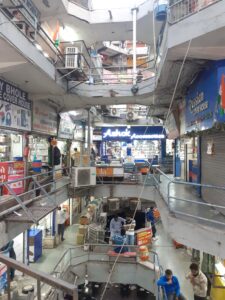Evolving Mobile Repair Business in Ahmedabad City, India
Guest Blog Post by Himadri Das, former 2021 Summer Fellow
Is increasing consumerism a death knell for repair?
The classic conundrum of consumerism with respect to sustainability plays out in complex ways. One would imagine that mobile phones, which are undoubtedly an indicator of increasing consumerism in the Indian cities, would flush the markets with cheap and not-so-cheap models thereby relegating possibilities of second-hand phone use or repair of phones to the very minimum.
Or does the rapid expansion of the mobile phone business also spawn second-hand-use phone sales which in turn supports a thriving repair industry as well?
The answer to this question is sought through a case study of mobile repair businesses in the city of Ahmedabad, India.
The mobile phone is the biggest disrupter of our times. Mobile phones have helped connect millions in India. More so in a country like India which is still in the process of urbanizing. In the Indian cities, the concentration of inhabitants is higher than provisions for everyday needs or jobs or housing. These basic needs would always be in a perpetual state of shortage. In such a context, mobile phones were a kind of unique identification for individuals to stake their claim to the modernity offered by the city. Going by the number of people that stood to benefit from it, the mobile phone disrupts more people than the printing press or the watch or the automobile, while offering the advantages of all the three in one package (Jeffrey & Doron, 2011).
So does widespread use of mobiles mean a growing need for mobile repair businesses also? If so, how do these businesses square up to the demand? What are the Challenges and Diversification of mobile repair businesses? How do the primarily informal businesses surmount the Challenges and resultant Diversification?
A total of 30 respondents were interviewed in various parts of the city. Some of the older businesses were located in the walled city and in the south-eastern suburban areas close to the second railway station. The younger businesses were located at new residential and commercial suburbs to the west of the city and significantly, a wholesale market dedicated to mobile accessories and repair has sprung up at the main bus station of Ahmedabad.
Challenges in growth and evolution of the mobile repair market in Ahmedabad city.
A respondent suggested: I should ask which business mobile repairers would take up, if they left this business. He gives me a curious answer and asks me to check with others. He says they would go to the catering business.
Most respondents did not start the mobile repair business as their first business. Many of the respondents came to mobile repair because it is a low-investment business. They brought with them experience from other businesses. The respondents were engaged in related businesses, like running shops that were selling imported Chinese-made electronics, running STD (Subscriber Trunk Dialling) shop and selling SIM cards (for mobiles) and in one case, making video game apparatus with TV screens and control panels. The focus of the government on stabilizing manufacturing in India led to many changes in the electronics market. Import of Chinese-made electronics dwindled owing to regulations and tax regime. Though the pre-paid mobile SIM is still a large percentage of total mobile connectivity in India (Statista Research Department, 2023). The SIM card business was disrupted by a cell phone company by the name Reliance-Jio. They brought online recharge in an effort to simplify recharging and thereby widening the net of mobile connectivity. The video games were rendered illegal and deemed ‘gambling’. So the manufacturers of video games, who would have to get a ‘stay-order’ from the courts in order to continue to produce the apparatus, stopped in 1999. The individuals who were involved in these businesses moved to mobile repair as they perceived this to be a growing business. The fact that many respondents do not have technical qualifications relevant to mobile repair business is due to this reason.

Among the respondents, the individuals who were involved in other businesses had passed upto Standard 10th or Standard 12th. For them the objective was to set up any new-business. Mobile repair was a low investment business in which one could start with 5000 INR (60$*) with a small 120 sq ft (square feet) space in the market on the main street of the walled city of Ahmedabad. The rents for the space in those days were in the range of 2000 INR (24$*), today it is more than 12 times at 25000 INR (300$*).
The mobile repair businesses have changed much since the early days. Initially, mobile repair for the western state of Gujarat was centred around Ahmedabad, that too in the markets located in the walled city and in close proximity to the railway stations. These markets would get dealers coming from nearby towns for spare parts and repairs. The best years were around 2010 to 2012, as said by a repairer. He claimed there were so much crowds, that there would be no space for people to stand inside the shops. Now there are many other big markets such as the one at the main Bus station and the one at Janpath on Ashram road, which is a newer city-center. Even small towns and villages in the hinterland have repair shops. The repairers say that while the number of customers has increased manifold the number of shops have also increased leading to over-supply.
The fact that mobile companies have flooded the market with cheap smartphones has resulted in an increase of the repair business too. But new models with new components proliferate in the market. Some of the repairers depute younger workers to constantly scan the internet to understand new technology, new methods of disassembly and repair by accessing social media. So for example, i-phones with sandwhich I.C. Boards, says a repairer, need a special temperature controlled soldering iron. The repairers need to stay updated with such critical information to make sure they are able to do their job to the satisfaction of customers. But there are cases of businesses closing down, particularly those who depended on mobile-selling. The online market has taken away the advantage.
Diversification of mobile repair businesses in Ahmedabad city, Impact of CoVID and other opportunities:
A respondent says that repair business has grown in the post CoVID-19 years. He says this is due to increased usage of mobile phones. So simply put, more phones means more repairs
CoVID-19 affected the repair business in many ways. One major impact was that there was an incentive to go online. So repairers tested possibilities of working from home locations, placing orders online, taking payments by digital means etc. However, a more fundamental change was triggered by customer preference for refurbished or reused mobile phones and tablets. Most respondents reported that while mobile selling business declined since 2014, the repair, refurbishing, re-used phones business saw an upswing.
One repairer said that refurbishing is distinct from a reused phone. A refurbished phone is one in which the parts have been changed. Most likely it is not the same as the original in terms of performance. However, the increase in demand post CoVID-19 has resulted in this kind of illegal practice as well. He surmises that 90% of the i-phones in the seconds-market are refurbished. He says many repairers have made money by such dishonest practices during the post CoVID-19 demand of used phones. However, He says realistically speaking, it is possible to grow at 10-15% every year in the repair business without indulging in illegal practices.
According to respondents, the CoVID-19 period resulted in not only more use of mobiles but also widespread use. Some of the respondents restarted their business in new locations using this trigger as a driving point. They argue that earlier in a family of five there would be two phones, today a family of three would have five phones. This is primarily due to online access to education, business and proliferation of e-commerce.

Mobile repair has become more lucrative but at the same time there are not enough skilled professionals who can repair at a complex level. The lockdown period was a testing time for repairers just as it was for others. Many were forced to move from the locations they had set up earlier. One respondent describes this period as the one that resulted in him meeting a partner for business with common interests. Having shut down a shop in Surat a city in the southern parts of the state of Gujarat, he moved to his home-town of Mohua in Bhavnagar district which is across the Gulf of Khambat to the west of the state of Gujarat. There he met another repairer who had a shop in the main bus station at Ahmedabad, which is the capital of the state of Gujarat and located due north of the state. Their idea was to start a repair training business together.
Starting with a thorough scan of the mobile repair training landscape they found that there was a huge gap waiting to be filled. They visited all the training institutes in Ahmedabad and understood the courses that were being offered not only in terms of costs but also the content. For their institute, they designed two types of courses: a basic course of forty five days with three hours per day of training and an advanced course of fifteen days with seven hours per day of training. While the courses offered by them are more expensive than the ones in other institutes in the city, the equipment they have in their laboratory is far superior in number and technicality. So private entrepreneurs have been able to bridge the gap in training where government interventions were needed but clearly missing.
The study therefore supports the fact that the mobile repair business is in fact growing and many youngsters see this as lucrative enough to invest time and money to go back and set up their own business.
While the main challenges are those of lack of a trained work-force, the business owners have identified this issue and tried to bridge the gap. The other big challenge is keeping upto date with the new models and technologies that are being brought into the market by mobile companies, this is further exacerbated by the fact that most repairers do not have the requisite training to understand the engineering that goes into making a mobile. In terms of diversification, the repair businesses have dispersed from the erstwhile clusters in the walled city to clusters in the new parts of the city. While this process is complex and factors such as ensuring access to customers need to be balanced with having access to spares and parts. The invisible layer of access to information regarding the new technologies also plays a part in choosing locations. The present day mobile repair businesses have taken more inventive formats. Some businesses are run from shops, some from kiosks within shops selling new mobiles and accessories and yet others operate like back end offices with limited interface with customers. These shops have the wherewithal to provide repair services to small kiosks who in turn interface with customers.
(*) Dollar rates as per 01 December 2023
Acknowledgements:
This blog is based on excerpts from an unpublished paper submitted by Himadri Das (@Himadri-urbanist), as part of Phd coursework at CEPT University, Ahmedabad, India